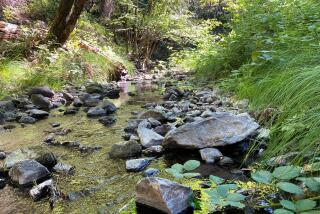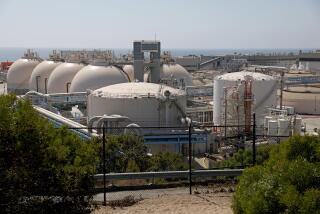EPA Rejects Waiver of Tighter Standards at Carson Sewage Plant : Environment: Plant pumps estimated 365 million gallons of effluent into ocean daily. Sanitation officials say they’ll fight tentative decision.
The U.S. Environmental Protection Agency on Tuesday tentatively rejected a request for a federal waiver to exempt the Los Angeles County Sanitation Districts’ sewage plant in Carson from tighter treatment standards.
The decision concerns an estimated 365 million gallons of effluent that the Carson plant pumps daily through ocean outfalls about 1 1/2 miles off the Palos Verdes Peninsula.
Sanitation officials have argued that the waste is clean enough and that removing more solids from it would be dangerous because they help cap a layer of bay sediment contaminated in the 1950s and ‘60s by hundreds of tons of the pesticide DDT.
Daniel McGovern, the EPA’s regional administrator, rejected both arguments in a statement issued Tuesday. He said the agency could not legally grant a waiver based on the DDT concerns and added: “EPA has determined that the discharge is not needed to ensure that the DDT remains buried.”
McGovern said the county sanitation districts failed to meet several key conditions for a waiver.
“Most importantly, the county did not demonstrate that its waste-water discharge would allow the natural fish and shellfish populations to thrive on the Palos Verdes Shelf,” he said. “EPA found that many native species that are sensitive to pollution could not tolerate the county’s discharge.”
Tuesday’s tentative ruling is subject to a public comment period and, if it is made final, to administrative and judicial appeal. But opponents of the waiver termed the decision a key turning point in the sanitation districts’ 11-year battle to win an exemption from tougher federal treatment standards.
Environmentalists and lawmakers from coastal communities have long argued that intensified treatment would spare Santa Monica Bay from large amounts of oil, grease, toxic metals and other pollutants contained in effluent from the Carson plant.
“This is a very positive and significant decision for Santa Monica Bay,” said U.S. Rep. Mel Levine (D-Santa Monica). “EPA is showing its muscle by demonstrating they are not afraid to ‘Just say no’ to polluters.”
But the sanitation districts issued a statement saying they “disagree strongly” with the EPA decision, and hinting they will fight if it becomes final. The statement said there is an “exhaustive amount of evidence” showing the districts qualify for a waiver, and drew attention to the problem of the buried DDT.
An estimated 1,800 tons of DDT were discharged in sewage pumped through the Carson outfalls in the 1950s and ‘60s, and 200 tons of it are believed to still be embedded in a 13.5-square-mile area of sediment off Palos Verdes Peninsula. The sanitation districts contend that solids from the plant have played a key part in keeping the harmful pesticide buried.
“Because we believe EPA made the wrong decision for the environment, we will continue to pursue the recourse offered to us by law,” the districts’ statement said.
Sanitation officials have estimated it would cost ratepayers $350 million to meet a federal requirement that sewage plants provide full secondary treatment, a system that makes use of biological processes to remove 85% of solids from waste water.
Already, secondary treatment is provided for 60% of the effluent from the Carson plant, which serves cities stretching from Palos Verdes Estates to Pomona. But the rest receives primary treatment, a less intensive method of removing solids that involves settling, screening and the use of chemicals.
The EPA believes that if fewer solids flow through the Palos Verdes outfalls, natural sedimentation in the area would still keep the DDT covered, said Loretta Barsamian of the agency’s wetlands, oceans and estuaries division.
More to Read
Sign up for Essential California
The most important California stories and recommendations in your inbox every morning.
You may occasionally receive promotional content from the Los Angeles Times.










